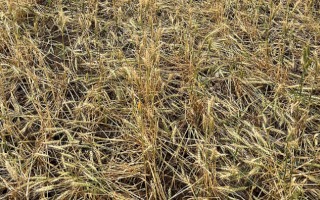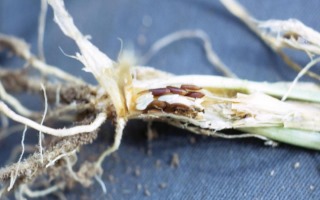By Adam Varenhorst
Recent reports of lodged wheat suggested that wheat stem sawfly may be causing issues in central South Dakota (Figure 1).

However, the lodged plants all had brown, flax-seed-like objects (approximately on-eighth of an inch long) at the base of the plant between the leaf sheath and the stem.
The flax-seed-like objects found in the plants were identified as Hessian fly pupae (Figure 2).

In the case of the affected fields, the Hessian fly larvae began feeding on the plants after stem elongation, which weakens the stems. This can lead to decreased yields and difficulty harvesting the crop. This also indicates that the infestation of the affected fields occurred during the spring of 2023.
The presence of Hessian fly pupae also indicates the risk of having infestations occur during fall 2023. In South Dakota, there is a spring population and a fall population of Hessian flies. The pupae indicate the end of the spring population, but the flies that emerge during August and September could result in winter wheat infestations.
Management Strategies
Resistant Cultivars
Planting resistant wheat cultivars for Hessian flies can help to suppress populations. There are currently 34 Hessian-fly-resistant genes identified. However, it is important to rotate cultivars to help eliminate the chance of pests developing resistance.
Fly-Free Dates
Avoid planting (if possible) until after a fly-free date. Fly-free dates have been used to determine when Hessian fly activity has ceased during the fall, and planting is “safe.” However, these dates can vary depending on many environmental factors. In South Dakota, the estimated fly-free dates are September 30 for the northern half of the state and October 15 for the southern half of the state (based on North Dakota’s fly-free dates).
Crop Rotation
Hessian flies have a very limited host range. Avoid planting wheat back-to-back where problems with Hessian flies have previously occurred.
Weed Removal
Remove any volunteer wheat or “green bridges” prior to planting wheat. This will reduce egg laying sites and overwintering populations.
Source : sdstate.edu